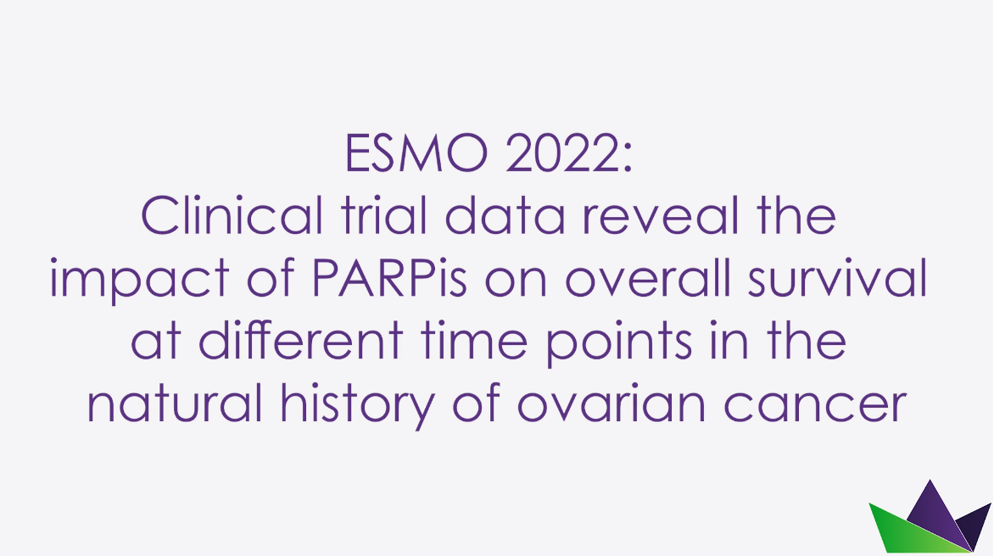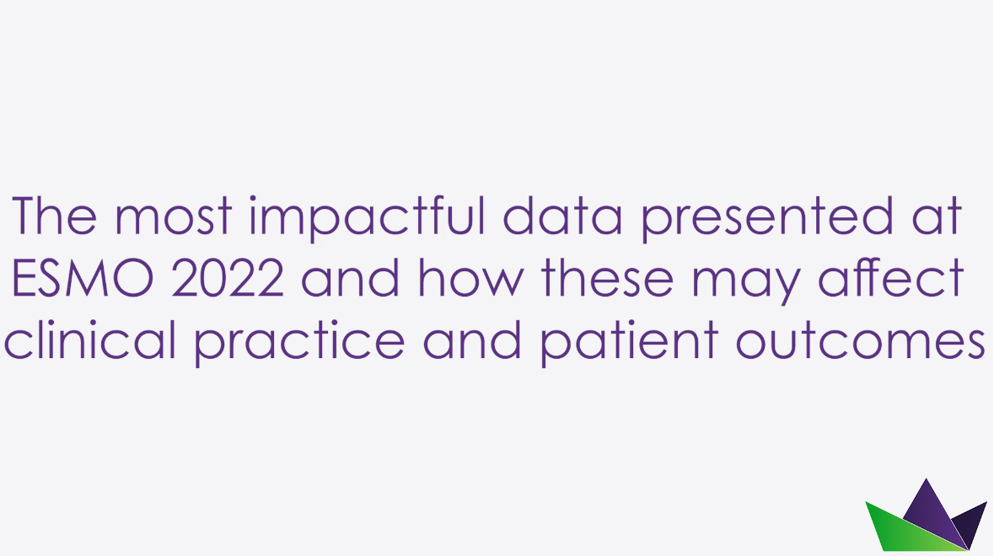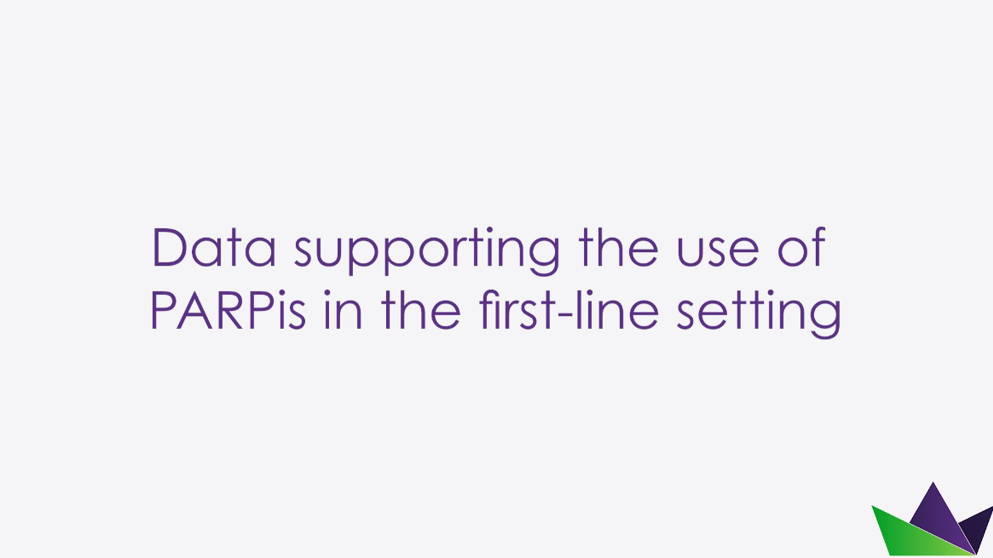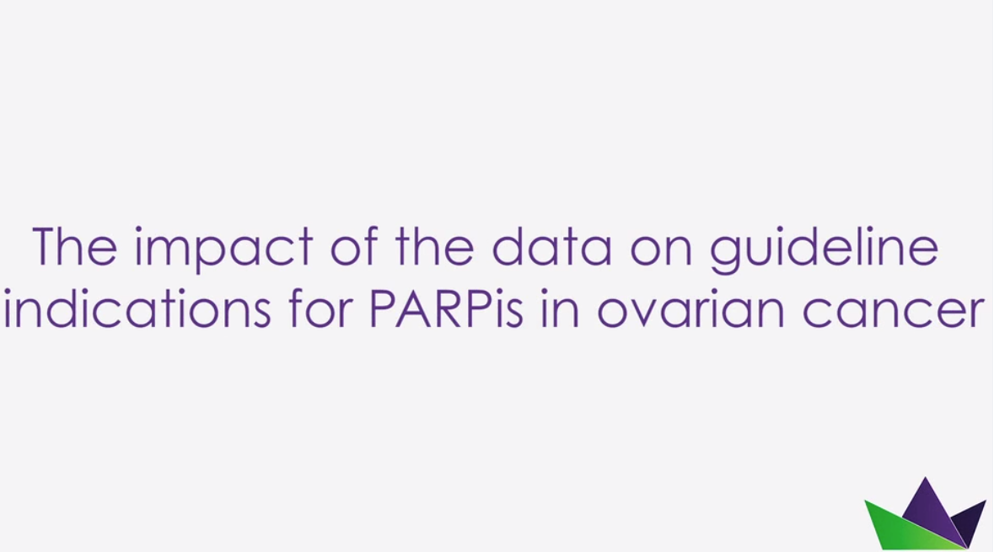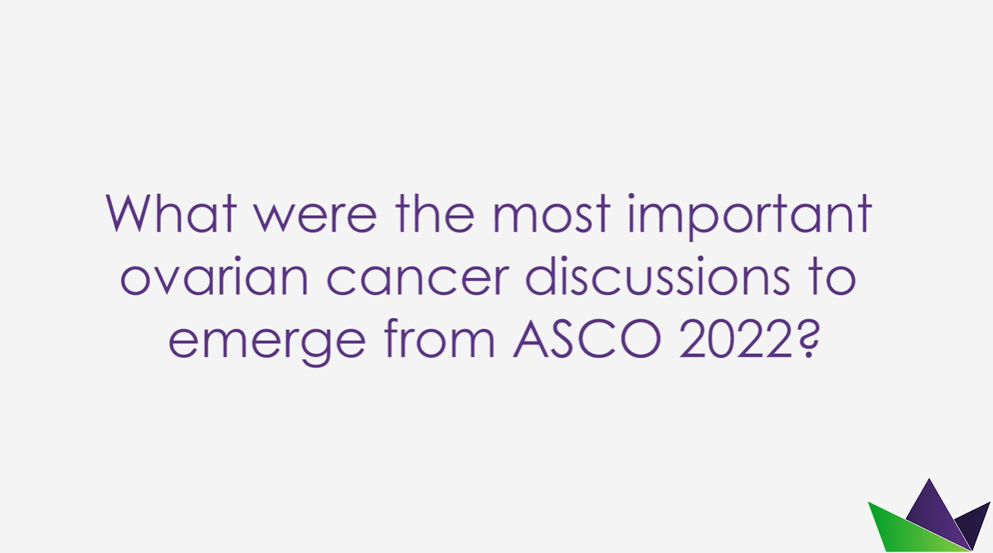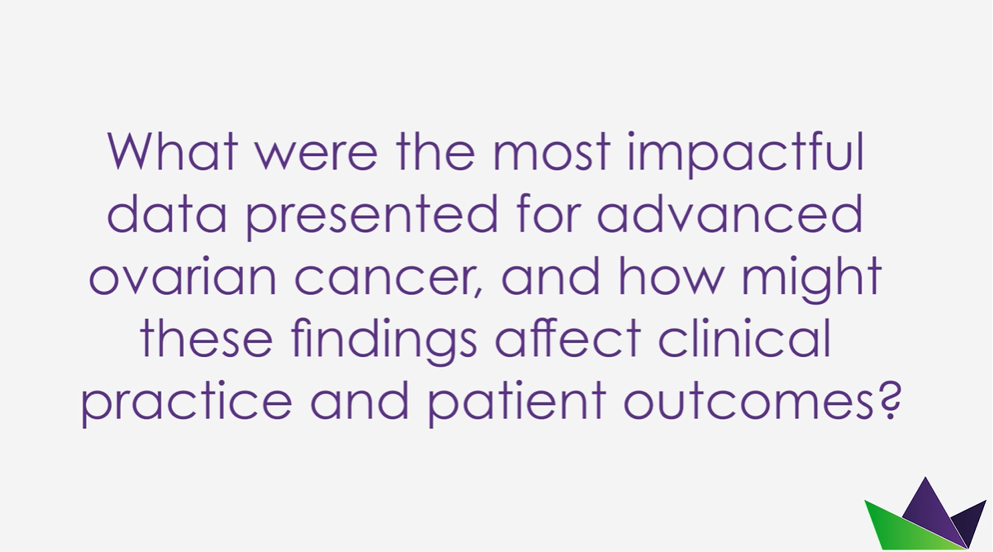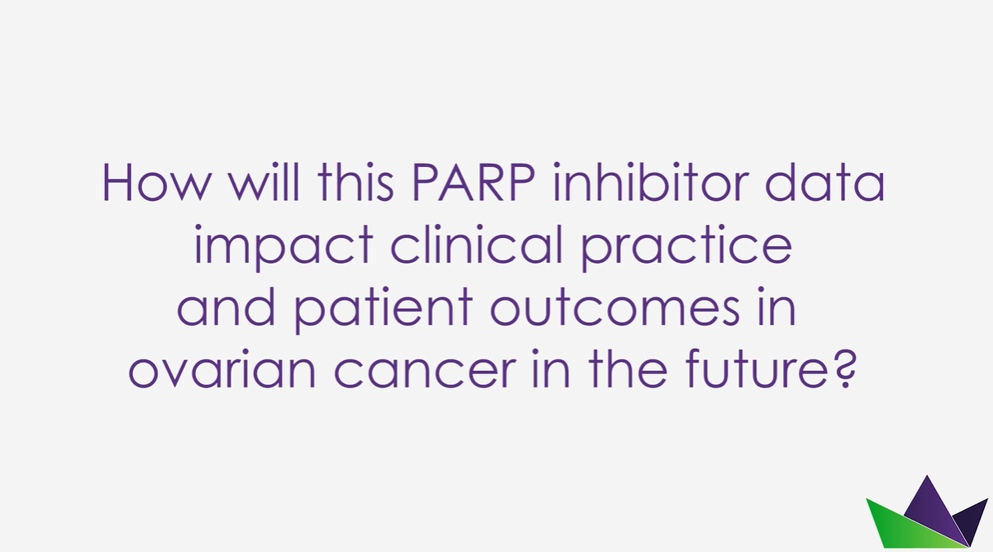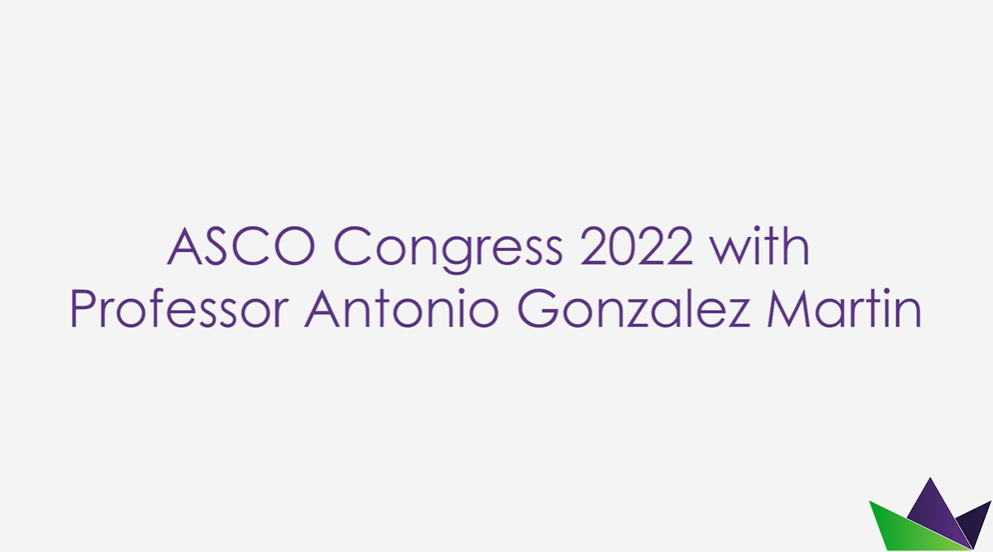Congress highlights
Join us for congress highlights on PARP inhibitor treatment of ovarian cancer at ESMO 2022, ASCO 2022, ESMO 2021 and ASCO 2021.
- Discover the emerging clinical trial data in the first-line and recurrent maintenance settings
- Learn about the real-world outcomes achieved with PARP inhibitor treatment
- Find out how PARP inhibitor treatment outcomes are being improved in different patient groups
In this section
ESMO 2022
Discover what was discussed at ESMO 2022, with Professor Antonio González-Martín sharing the most impactful data presented on PARP inhibitor use in ovarian cancer and describes how it may affect clinical practice and patient outcomes.
ESMO 2022
Ovarian cancer update and the theme of ESMO 2022
By Heather L. Mason
ESMO 2022 Theme
The theme ‘sustainability’ was evident throughout this year's congress. In light of the potential impact of recent scientific advances, sustainability must also include the infrastructure of our healthcare systems, equitable access to drugs, and optimisation of the quality of life for patients. Naturally, sustainability also refers to the environment, with air pollution having a proven impact on public health. Educational events such as this congress can contribute to information dissemination and awareness of preventative measures. For instance, and ESMO report claimed that over 40% of cancers are avoidable.
Presenters discussed air pollution, stating that it causes eight million deaths annually, which is claimed to be more than tobacco. Late breaking data have shown the role of IL-1b in the biological mechanisms that link air pollution and lung cancer.
Within the discussion of sustainability, the boom in precision medicine will ultimately lead to the detection of cancer in the earlier stages. However, following the COVID-19 pandemic healthcare systems are already struggling to provide an adequate level of care. Therefore, before the technology to facilitate early diagnosis can be rolled out, infrastructure must be put in place.
A year-long, European-wide cancer prevention campaign kicks off in October 2022, jointly initiated by ESMO and the European Oncology Nursing Society (EONS). PrEvCan sets out dietary and lifestyle recommendations, vaccination programs, and screening programs targeting different audiences, including vulnerable and difficult-to-reach groups. The aim is also to provide healthcare professionals with a toolkit for effective communication of cancer prevention1.
Updates in ovarian cancer
Are we improving the overall survival of people with ovarian cancer using PARP inhibitors?
The ten-year survival rate in women with newly diagnosed advanced ovarian cancer (AOC) is 17%, with relapsing AOC typically incurable. Thus, new effective first-line therapies are essential.
PAOLA/ENGOT-ov25 trial
Isabelle Ray-Coquard (Lyon, France) presented the final overall survival data from the phase III PAOLA/ENGOT-ov25 trial in patients with newly diagnosed advanced ovarian cancer who had previously received first-line standard-of-care treatment. Patients were stratified according to their BRCAm and homologous recombination deficiency (HRD) status.
The overall survival (OS) at the 5-year follow-up in the intention‑to‑treat (ITT) population was 47.3% in the olaparib+bevacizumab group, compared to 41.5% in the placebo+bevacizumab group (HR 0.92). In subgroup analysis, the OS increased to 65.5% in the HRD+ subgroup treated with olaparib, compared to 48.4% in the placebo group (HR 0.62; 95% CI, 0.45–0.85).
A 73.2% OS was seen in the BRCAm group and 54.7% in HRD+ (excluding BRCAm) group when treated with olaparib+bevacizumab. No benefit was seen in the HRD- group, highlighting the importance of precision medicine and biomarker testing to guide treatment decisions2.
Preliminary data from this trial showed that maintenance therapy for two years with olaparib (300mg twice daily) plus bevacizumab demonstrated a significant progression free survival (PFS) benefit compared to placebo plus bevacizumab
SOLO1 trial
In the SOLO1 trial, women with either the BRCA1 or BRCA2 mutation, or both, were treated with olaparib 300mg twice daily (n = 260) or placebo (n = 131) for two years. Patients were stratified according to their response to platinum-based chemotherapy3.
In the 5-year follow-up data, 48.3% of patients in the olaparib group were progression-free compared to 20.5% in the placebo group3.
Paul DiSilvestro (Women & Infants Hospital, Providence, USA) presented the 7-year follow-up OS data, the longest follow-up for any PARP inhibitor in newly diagnosed AOC. The OS at 84 months was 67% in the olaparib group, compared to 46.5% in the placebo group (HR 0.55; 95% CI, 0.40–0.76; P=0.0004 [P<.0001 required to declare statistical significance]), which was clinically meaningful but not statistically significant4. Subsequent PARP inhibitor therapy was given to 44.3% of patients in the placebo group compared to 14.6% in the olaparib group. The median time to first subsequent treatment (TFST) was substantially delayed in the olaparib group (64 months) compared to the placebo group (15.1 months). No new safety signals were observed after seven years. The incidence of myelodysplastic syndromes and acute myeloid leukaemia (MDS/AML) remained low, and new primary malignancies remained low between groups5.
The benefit of olaparib therapy extended beyond the 2-year treatment cap, supporting its use as a maintenance therapy to achieve long-term remission in BRCAm patients with newly diagnosed AOC
Results are also published in the Journal of Clinical Oncology4.
ARIEL4 trial
The phase III ARIEL4 study included patients with a deleterious BRCA1/2 mutation and advanced relapsed ovarian cancer. Patients were treated with rucaparib (n = 233), 600mg twice daily, or standard‑of‑care chemotherapy (n = 116) (2:1 ratio)6. Previous interim data revealed a significant improvement in investigator-assessed PFS in patients treated with rucaparib compared to those treated with chemotherapy.
Amit Oza (Princess Margaret Cancer Centre, University Health Network, Toronto, Canada) presented the final OS data in the ITT population. Secondary exploratory endpoint measures were OS according to platinum resistance or sensitivity, along with PFS2 in the ITT population.
OS was similar between treatment groups among patients with platinum-sensitive disease6.
The difference in OS in the ITT population was driven by the platinum-resistant subgroup
In the platinum-resistant population, 42% of patients in the rucaparib group did not receive subsequent anticancer treatment, compared to 23.7% receiving chemotherapy. OS was also confounded by the high rate of cross-over therapy from chemotherapy to rucaparib, as 90% of patients received rucaparib after randomisation or cross-over6.
In the platinum-resistant population, translational analysis of pre- and post-treatment plasma samples identified a decrease in the BRCA reversion mutations in 3 of 4 paclitaxel-treated patients. Further work is ongoing to determine the biological basis of resistance and the optimal sequence of therapy6.
Improvements in progression-free survival have been demonstrated in trials of olaparib for advanced ovarian cancer, and the biological basis of platinum resistance may help determine optimal treatment sequencing of rucaparib in ovarian cancer
Should all AOC patients receive a PARPi in first-line therapy?
Almost 50% of ovarian carcinomas are due to homologous recombination deficiency (HRD) and while the BRCA mutation is a well-known cause of HRD, they account for only 14–20% of high-grade ovarian carcinoma7.
The decision to use a poly (ADP-ribose) polymerase inhibitor (PARPi) may depend on access, cost and toxicity profile
Despite all the data accumulated over the past few years, the advice on using a PARP inhibitor as a first-line treatment remains controversial. David Tan (Singapore) pulled together the information from recent trials to try to answer this question8. The trials in the BRCA mutant wild-type population, PAOLO-19, PRIMA10, PRIME11, ATHENA12 and SOLO-113, resulted in significant PFS benefits. HRD is the key phenotype that determines whether a PARPi would be of benefit as maintenance therapy in advanced ovarian cancer (AOC).
In the HRD-negative or indeterminate group of patients, three studies, PRIMA (niraparib, following platinum-based chemotherapy)10, PRIME (niraparib, maintenance)11 and ATHENA (rucaparib, maintenance)12, showed a benefit in PFS. However, this benefit was not seen in the PAOLO-1 trial (HR 0.92)9. In each trial, different HRD assays were used, with different cut-offs and test failure rates. Thus, HRD assays do not reliably exclude PARPi benefits.
Ovarian cancer is a heterogeneous disease with a spectrum of HRD negativity, and the response to platinum chemotherapy is not well defined. In a unique dataset of patients with high-grade serous ovarian carcinoma (HGSOC) subgroup treated with platinum monotherapy (SCOTROC 4 study)14, the translational analysis found that patients with cyclin E1 amplification were generally HRD negative with a poor prognosis and less likely to be platinum-sensitive. While some had a response to therapy, this did not translate to PFS. Quantitative analysis of RAD51 expression in the HRD-negative population found overexpression was a determinant for platinum resistance.
Another difference between the PARPi trials previously described was the use of bevacizumab. In a population-adjusted indirect comparison of PRIMA-eligible patients in PAOLA-1 versus PRIMA patients who were HRD-positive, the addition of bevacizumab to olaparib gave the greatest PFS benefit (36.0 months). Bevacizumab and niraparib were similar (17.4 and 22 months, respectively). While it is impossible to compare cross-trial data, the hypothesis is that the use of bevacizumab was superior to PARPi for PFS in the HRD-negative population.
Researchers continue to interrogate data from multiple clinical trials in an attempt to address whether PARP inhibitors may be suitable as a first-line treatment option for advanced ovarian cancer
Two prospective studies are underway: NIRVANA-1 trial niraparib with or without bevacizumab in maintenance after cytoreduction, and AGO-OVAR 28, niraparib monotherapy, or in combination with bevacizumab in patients with carboplatin-paclitaxel-based chemotherapy. Dr Tan commented that a bevacizumab alone arm in patients with HRD-negative tumours is an omission from these studies.
The use of PARPi in HRD-negative patients should be considered in the context of histology (immunogenic phenotypes treated with bevacizumab, then PARPi as maintenance) and the clinical response to platinum. There is a need to look at specific subtypes within HRD-negative patients to determine the benefits of PARPi and when to add them.
Mechanisms of PARPi resistance
Iain McNeish (Imperial College, London, UK) described complex mechanisms by which patients do not respond to PARPi15. The Cancer Genome Atlas (TCGA) studies have repeatedly shown that our germline mutation rate in BRCA1 and BRCA2 in newly diagnosed high-grade ovarian cancer is around 15%, and the somatic mutation rate around 5%, with an HRD rate of around 50%. Not all genes in the DNA damage response (DDR) pathway behave equally. Mutational analysis in preparation for the ARIEL-2 study showed that by knocking down 30 genes in the DDR pathway to determine their ability to sensitise to a PARPi, a huge variation was found. Thus, the link between DNA damage and the sensitivity to PARPi is very complex. Significantly, platinum sensitivity and PARPi sensitivity do not always overlap.
An important point to note on genomic analysis is that it attempts to apply a binary classification to a continuous variable and, consequently, will not capture all patients. In addition, genomic HRD scores change over time as they represent an imprint of all the mutational damage that has happened in that cell. So purely HRD assays may never be totally predictive of a PARP response. In the ARIEL study, loss of heterozygosity (LOH) scores went up from diagnosis to relapse in 17 of 117 patients, to the extent that they were reclassified. Also, PARP does not only influence DNA damage; it has multiple functions in the cell cycle, such as inflammatory signalling and transcriptional regulation. Thus, all these processes may also be interrupted by PARPi.
Stephanie Lheureux (Toronto, Canada) defined what is meant by treatment resistance16.
Platinum sensitivity and PARPi sensitivity do not always overlap
The gynaecology cancer intergroup (GCIG) Symptom Benefit Committee17 provides consensus guidelines on defining treatment response. How do we define PARPi resistance? Do we use the same timing as defined for platinum resistance? The OREO study aimed to determine the effect of a PARPi rechallenge. The study included patients with platinum-sensitive relapsing ovarian cancer, one previous PARPi, and in response to platinum-based chemotherapy18. Most patients had the PARPi at the time of maintenance relapse. Researchers learnt that prior PARPi exposure is different to PARPi resistance. Usually, PARPi is used as first-line therapy for a specific duration, but most recurrences will occur after PARPi discontinuation. There is no established treatment-free interval defining PARPi sensitivity, so we must identify a resistance mechanism. The main target for PARPi is the DNA repair pathway, which is the same as platinum chemotherapy. Several mechanisms have been identified: epigenetic, with loss of BRCA1/RAD51C promoter methylation; genetic, correcting secondary reversion mutations in the HRD gene; alternative BRCA1 isoform expression; or a change in DNA damage repair proteins. The most described mechanism of resistance is the reversion mutation.
In an analysis of 327 patients with BRCA1 or BRCA2 mutations on progression after platinum or PARPi, 21% (BRCA1) and 27% (BRCA2) of patients had reversion mutations19. Potentially looking at the genomic landscape in real-time and prior to protracted treatment regimens, reversion mutations may be prevented.
References
- The frontline oncology workforce unites to reduce the burden of cancer before it hits [ESCMO Congress 2022 press release]. https://www.esmo.org/newsroom/press-releases/the-frontline-oncology-workforce-unites-to-reduce-the-burden-of-cancer-before-it-hits. Accessed 15 September 2022.
- Ray-Coquard I. Final overall survival (OS) results from the phase III PAOLA-1/ENGOT-ov25 trial evaluating maintenance olaparib (ola) plus bevacizumab (bev) in patients (pts) with newly diagnosed advanced ovarian cancer (AOC). Presented at the ESMO Congress 2022, 09 September. Paris. LBA29.
- Banerjee S, Moore KN, Colombo N, Scambia G, Kim B-G, Oaknin A, et al. Maintenance olaparib for patients with newly diagnosed advanced ovarian cancer and a BRCA mutation (SOLO1/GOG 3004): 5-year follow-up of a randomised, double-blind, placebo-controlled, phase 3 trial. The Lancet Oncology. 2021;22(12):1721-1731.
- Disilvestro P, Banerjee S, Colombo N, Scambia G, Kim B-G, Oaknin A, et al. Overall Survival With Maintenance Olaparib at a 7-Year Follow-Up in Patients With Newly Diagnosed Advanced Ovarian Cancer and a BRCA Mutation: The SOLO1/GOG 3004 Trial. Journal of Clinical Oncology. 2022;0(0):JCO.22.01549.
- DiSilvestro P. Overall survival (OS) at 7-year (y) follow-up (f/u) in patients (pts) with newly diagnosed advanced ovarian cancer (OC) and a BRCA mutation (BRCAm) who received maintenance olaparib in the SOLO1/GOG-3004 trial. Presented at the ESMO Congress 2022, 09 September. Paris. 517O.
- Oza A. Overall survival results from ARIEL4: A phase III study assessing rucaparib vs chemotherapy in patients with advanced, relapsed ovarian carcinoma and a deleterious BRCA1/2 mutation. Presented at the ESMO Congress 2022, 09 September. Paris. 518O.
- Bonadio RC, Estevez-Diz MDP. Perspectives on PARP Inhibitor Combinations for Ovarian Cancer. Frontiers in oncology. 2021;11:754524.
- Tan DS. Should all advanced ovarian cancer patients receive a PARPi in first-line therapy? Presented at the ESMO Congress 2022, 11 September. Paris.
- Ray-Coquard I, Pautier P, Pignata S, Pérol D, González-Martín A, Berger R, et al. Olaparib plus Bevacizumab as First-Line Maintenance in Ovarian Cancer. New England Journal of Medicine. 2019;381(25):2416-2428.
- González-Martín A, Pothuri B, Vergote I, DePont Christensen R, Graybill W, Mirza MR, et al. Niraparib in Patients with Newly Diagnosed Advanced Ovarian Cancer. N Engl J Med. 2019;381(25):2391-2402.
- Li N. Efficacy and safety of niraparib as maintenance treatment in patients with newly diagnosed advanced ovarian cancer using an individualized starting dose (PRIME study): a randomized, double-blind, placebo-controlled, Phase 3 trial. Presented at the SGO 2022, 19 March. Tampa, Florida. LBA 5.
- Monk BJ, Parkinson C, Lim MC, O'Malley DM, Oaknin A, Wilson MK, et al. ATHENA–MONO (GOG-3020/ENGOT-ov45): A randomized, double-blind, phase 3 trial evaluating rucaparib monotherapy versus placebo as maintenance treatment following response to first-line platinum-based chemotherapy in ovarian cancer. Journal of Clinical Oncology. 2022;40(17_suppl):LBA5500-LBA5500.
- Moore K, Colombo N, Scambia G, Kim B-G, Oaknin A, Friedlander M, et al. Maintenance Olaparib in Patients with Newly Diagnosed Advanced Ovarian Cancer. New England Journal of Medicine. 2018;379(26):2495-2505.
- Banerjee S, Rustin G, Paul J, Williams C, Pledge S, Gabra H, et al. A multicenter, randomized trial of flat dosing versus intrapatient dose escalation of single-agent carboplatin as first-line chemotherapy for advanced ovarian cancer: an SGCTG (SCOTROC 4) and ANZGOG study on behalf of GCIG. Annals of Oncology. 2013;24(3):679-687.
- McNeish I. Can we identify the patients who will most likely benefit through HRD tests? Presented at the ESMO Congress 2022, 10 September. Paris.>
- Lheureux S. PARPi resistance: What do we know now? Presented at the ESMO Congress 2022, 11 September. Paris. Special symposium.
- Woopen H, Sehouli J, Davis A, Lee YC, Cohen PA, Ferrero A, et al. GCIG-Consensus guideline for Long-term survivorship in gynecologic Cancer: A position paper from the gynecologic cancer Intergroup (GCIG) symptom benefit committee. Cancer Treatment Reviews. 2022;107:102396.
- Selle F, Asselain B, Montestruc F, Bazan F, Pardo B, Salutari V, et al. OReO/ENGOT Ov-38 trial: Impact of maintenance olaparib rechallenge according to ovarian cancer patient prognosis—An exploratory joint analysis of the BRCA and non-BRCA cohorts. Journal of Clinical Oncology. 2022;40(16_suppl):5558.
- Tobalina L, Armenia J, Irving E, O'Connor MJ, Forment JV. A meta-analysis of reversion mutations in BRCA genes identifies signatures of DNA end-joining repair mechanisms driving therapy resistance. Annals of Oncology. 2021;32(1):103-112.
ASCO 2022
Join Professor Antonio González-Martín in this series of videos to hear about ovarian cancer treatments that were discussed at the ASCO 2022 congress.
The annual American Society of Clinical Oncology (ASCO) 2022 presented leading research in oncology. Cancer care, patient care, and novel treatments were covered in dynamic educational and scientific sessions at the 58th annual meeting of ASCO, which ran over five days from 3–7 June 2022 in Chicago, USA.
Below, we have summarised some of the most exciting innovations discussed in over 5,000 abstracts and presentations delivered at ASCO 2022, including recent data from the ATHENA-MONO, PRIME, ENGOT-OV16/NOVA, and AVANOVA trials, as well as research into combination PARP inhibitor treatments.
Hot topics at ASCO 2022
According to the ATHENA-MONO study presented at the 2022 ASCO Annual Meeting, maintenance rucaparib improved clinical outcomes compared with placebo for patients with ovarian cancer. Researchers have previously demonstrated that PARP inhibitors are an effective maintenance therapy for women with ovarian cancer following first-line treatment. However, there has been uncertainty as to whether all patients will benefit equally from this strategy, including those with BRCA mutations, those with high-risk clinical characteristics, such as residual disease or those with homologous recombination deficiencies (HRDs)1.
In the phase 3 ATHENA trial (NCT03522246), rucaparib was evaluated as maintenance therapy after first-line treatment for ovarian cancer in a large population of patients. The results of the ATHENA-MONO branch of the overall study were presented at ASCO 2022 by Bradley J. Monk, MD, of the University of Arizona College of Medicine in Phoenix. A total of 64 patients with high-grade, stage III-IV ovarian cancer underwent cytoreductive surgery and received at least four cycles of platinum-doublet chemotherapy. Based on their HRD status, surgery timing, and presence or absence of residual disease, patients were assigned 4:1 to maintain oral rucaparib or placebo intake with PFS (progression-free survival) being the primary endpoint assessed by investigators1.
A total of 427 patients received rucaparib, while 111 received a placebo with the HRD population consisting of 185 and 49 people, respectively; of these, 425 and 110 people underwent treatment. The median treatment times were 14.7 months in the rucaparib group compared with 9.9 months in the placebo group. The investigator analysis revealed an improvement in PFS for patients with intent-to-treat (median, 20.2 months vs 9.2 months with placebo; hazard ratio, 0.52; P<0.0001), as well as for patients with HRD (median, 28.7 months vs 11.3 months with placebo; P=0.0004) 1.
Secondary endpoint PFS, assessed by a blinded independent central review, supported these results, with hazard ratios for the intent-to-treat and HDR groups of 0.47 (P=0.0001) and 0.44 (P=0.0005), respectively, supporting clinical benefit from rucaparib. Anaemia (28.7% vs 0%, respectively) and neutropenia (14.6% vs 0.9%) were the most frequent treatment-related adverse events in the rucaparib vs placebo groups. Rucaparib group participants experienced both dose reduction (49.4%) and interruption (60.7%)1.
Updates on PARP inhibitors in ovarian cancer
With an improved safety profile, niraparib maintenance therapy may benefit a larger population of newly diagnosed advanced ovarian cancer patients. The phase III PRIME study found that in patients with newly diagnosed advanced ovarian cancer, maintenance therapy with the PARP inhibitor niraparib led to a significantly longer progression-free survival compared with placebo (24.8 months vs 8.3 months; HR=0.45; 95% CI, 0.32–0.61; P<0.001)2. It is notable that, in contrast to the PRIMA study, which resulted in niraparib being approved as maintenance therapy, the PRIME study also enrolled patients with stage III ovarian cancer who had no residual disease after primary surgery2,3.
Patients with advanced ovarian cancer with high-grade serous or endometrioid tumours who had a complete or partial response to first-line platinum-based chemotherapy were enrolled in the double-blind, placebo-controlled PRIME study. All patients were randomized to receive niraparib or placebo and stratified according to their germline BRCA mutation status, homologous recombination-deficiency (HRD) status, neoadjuvant chemotherapy consumption, and first-line chemotherapy response2.
The treatment was continued for 36 months, or until the disease progressed or toxicities became unacceptable. All patients were given an individualized dose of 200 or 300 mg daily, depending on their body weight and platelet count. By blinded independent central review, the primary endpoint was progression-free survival in an intention-to-treat population2.
In the PRIME trial, 381 patients were enrolled (254 were given niraparib and 127 placebo). A median follow-up of 27.5 months was recorded on September 30, 2021, and 40% of the niraparib group remained on treatment, compared with 22.5% of the placebo group. Approximately 71% of patients randomly assigned to niraparib had stage III ovarian cancer, 83% responded thoroughly to chemotherapy, and 33.3% carried germline BRCA mutations2.
Combination therapy treatments using PARP inhibitors
Previously, the selective PARP inhibitor niraparib significantly improved progression-free survival (PFS) relative to placebo when used as a single agent in recurrent ovarian cancer (OC) patients regardless of their BRCA or HRD status in the ENGOT-OV16/NOVA trial. It has also been shown that niraparib has been shown to be safe when combined with bevacizumab in the ongoing AVANOVA trial (NCT02354131)4.
AVANOVA is exploring the use of this combination as a strategy to increase tumour sensitivity to PARP inhibition. Among bevacizumab's antiangiogenic properties, hypoxia can be caused by downregulation of BRCA and RAD51, leading to PARP inhibition sensitising tumours and causing apoptosis via contextual synthetic lethality. In NOVA, BRCA and HRD status were insufficient to predict who would respond to niraparib; however, the cohorts with these biomarkers experienced a longer median PFS4.
Niraparib plus bevacizumab will be evaluated as maintenance therapy in the OVARIO study (NCT03326193) in advanced OC patients who have recovered from primary debulking surgery and responded to platinum-based chemotherapy with bevacizumab. This study will enrol 90 patients with epithelial ovarian, fallopian tube, or peritoneal cancer stages III-b and IV, regardless of BRCA status. After platinum-based chemotherapy, patients must achieve either a complete or partial response. OVARIO's primary objective is to achieve PFS at the 18-month milestone5.
PFS at 6 and 12 months and patient-reported outcomes will be the objectives for the exploration phase. The following patients should receive 300 mg daily if they weigh ≥77 kg and have a platelet count of ≥150,000/ Μl and 200 mg daily if they weigh <77 kg or have a platelet count of <150,000/ μL. Bevacizumab will be given at 15 mg/kg every three weeks up to 15 months5.
References
- Monk BJ, Parkinson C, Lim MC, et al. ATHENA–MONO (GOG-3020/ENGOT-ov45): A randomized, double-blind, phase 3 trial evaluating rucaparib monotherapy versus placebo as maintenance treatment following response to first-line platinum-based chemotherapy in ovarian cancer. Journal of Clinical Oncology. 2022;40:LBA5500-LBA5500. doi:10.1200/JCO.2022.40.17\_suppl.LBA5500
- Yin R, Li N, Wu L, et al. Efficacy of niraparib maintenance therapy in patients with newly diagnosed advanced ovarian cancer in phase 3 PRIME study: A subgroup analysis by response to first-line platinum-based chemotherapy. Journal of Clinical Oncology. 2022;40:5551-5551. doi:10.1200/JCO.2022.40.16\_suppl.5551
- Heitz F, Marth C, Henry S, et al. AGO-OVAR 28/ENGOT-ov57: Niraparib versus niraparib in combination with bevacizumab in patients with carboplatin-taxane based chemotherapy in advanced ovarian cancer—A multicenter, randomized, phase III trial. Journal of Clinical Oncology. 2022;40:TPS5612-TPS5612. doi:10.1200/JCO.2022.40.16\_suppl.TPS5612
- Campo D, Mirza MR, Berek JS, et al. The successful phase 3 niraparib ENGOT-OV16/NOVA trial included a substantial number of patients with platinum resistant ovarian cancer (OC). Journal of Clinical Oncology. 2017;35:5560-5560. doi:10.1200/JCO.2017.35.15\_suppl.5560
- Hardesty MM, Krivak TC, Wright GS, et al. OVARIO phase II trial of combination niraparib plus bevacizumab maintenance therapy in advanced ovarian cancer following first-line platinum-based chemotherapy with bevacizumab. Gynecologic Oncology. Published online June 2022. doi:10.1016/j.ygyno.2022.05.020
The European Society for Medical Oncology (ESMO) Congress was held virtually from 16–21 September 2021, and it featured a range of exciting developments in the field of oncology. The full programme included plenary debates, mini oral sessions and proffered paper sessions, unveiling the latest advances in the fight against ovarian cancer.
PARP inhibitors in the first-line and recurrent maintenance setting
Professor Eric Pujade-Lauraine and colleagues presented the results of the OReO/ENGOT Ov-38 trial, which is, according to the authors, the first Phase III study evaluating PARP inhibitor maintenance rechallenge in platinum-sensitive relapsed ovarian cancer patients.
This randomised, double-blind trial evaluated patients with non-mucinous platinum-sensitive relapsed ovarian cancer who had received one prior line of PARP inhibitor maintenance therapy, and had responded to their most recent platinum-based chemotherapy. Patients were enrolled into BRCA1/2 mutated and non-BRCA mutated cohorts, and randomised to receive olaparib or placebo until progression.
The trial met its primary endpoint of investigator-assessed progression-free survival (RECIST v1.1). The results indicate that irrespective of BRCA mutation status, maintenance olaparib led to a significant improvement in progression-free survival compared to placebo. In addition, clinically relevant long-term benefit was observed in a subset of patients studied, and safety was consistent with olaparib’s known safety profile.
In other news, Dr. Manuel Rodrigues and colleagues presented the results of their study into real-world clinical outcomes in patients in France with de novo high-grade epithelial ovarian cancer eligible for niraparib per EMEA approval (the PRIMA trial). Their analysis of 488 patients with a median follow-up of 36 months indicated an estimated 36-month overall survival rate of 65.6% (95% CI, 59.1–72.1). The team concluded that clinical outcomes in patients with high-grade epithelial ovarian cancer (HGEOC) can be confirmed by analysis of large real-world cohorts with structured data. The results of this study aligned with the results of clinical trials for de novo HGEOC patients who responded to first-line platinum-based chemotherapy without maintenance therapy (bevacizumab or PARP inhibitor).
PARP inhibitors in the maintenance setting
Based on the ARIEL3 trial results, rucaparib was approved as monotherapy for maintenance treatment of recurrent epithelial ovarian cancer in which patients had prior complete/partial response to platinum-based chemotherapy. In a presentation by Dr. Mark Lythgoe and colleagues, they expressed the need for more real-world evidence of rucaparib treatment as it applies to routine practice. In their presentation, Dr. Lythgoe et al. shared the results of their multi-centre retrospective study, in which 119 patients receiving rucaparib in the UK via an early access program were studied. The results indicated a lower incidence of toxicity (any grade and grade 3/4), and discontinuation rates comparable with those observed in ARIEL3. Although they observed lower overall progression-free survival and BRCA mutation progression-free survival than in ARIEL3, when they applied similar inclusion and exclusion criteria to this real-world sample, progression-free survival findings were commensurate.
Improving PARP inhibitor treatment outcomes
Dr Valtcheva and colleagues presented the results of their investigation into the performance of the amplicon-based Oncomine™ BRCA1 and BRCA2 assay, which indicated reliable detection of large genomic rearrangements in formalin-fixed paraffin-embedded tumour tissue. The presenters propose that testing for somatic BRCA mutations should be routinely offered as pre-screening after ovarian cancer diagnosis, and prior to germline BRCA testing, which could contribute to a reduction in time for treatment decision, particularly considering that in general, only those patients harbouring somatic BRCA mutations are referred to genetic counselling and germline testing.
S. Manacorda et al. presented the findings of their retrospective study into the safety and efficacy of platinum desensitisation treatment in ovarian cancer patients who had been treated with carboplatin (CBDCA)-paclitaxel based chemotherapy or cisplatin. Their results indicated that desensitisation protocols with platinum-based regimens are effective and safe, which is promising news given the authors’ claim that over 70% of patients with advanced ovarian cancer develop a relapse 10–20 months after standard first-line treatment with CBDCA-paclitaxel based chemotherapy, and repeated exposure to platinum can result in hypersensitive reactions that can be life-threatening.
Dr. Thibault De La Motte Rouge and colleagues presented an ePoster on a new GINECO study, GREAT: A multicentric cohort of advanced ovarian cancer treated in real life with prospective collection of clinical data, tumour sample, and biomarkers including genomic putative theranostic markers. This trial aims to gain a better understanding of genomic alterations aside from BRCA and their effect on disease progression in order to inform the development of next generation therapies and enhance patient outcomes. This trial points to the future of ovarian cancer treatment, which will hopefully include an improved ability to select those patients who will derive the greatest benefit from PARP inhibitor treatment.
PARP inhibitor resistance
Dr. Yoo-Na Kim and colleagues presented the results of their investigation of PARP inhibitor resistance. In this study, circulating tumour DNA was analysed in ovarian cancer patients treated with PARP inhibitors. Recurrence was observed in 23 of the 55 patients enrolled, and preliminary analysis was performed in nine patients with paired circulating tumour DNA (ctDNA) samples before and after PARP inhibitor treatment. In one patient, BRCA mutation reversion occurred.
Pre-treatment samples revealed ctDNA-specific mutations associated with various signalling pathways, which were not observed in tumour sequencing data. In addition, variants were observed in samples analysed after progression on PARP inhibitors, which were not seen in the matched patient samples before therapy. These included druggable target genes. The presenters conclude that ctDNA can help reveal PARP inhibitor response, and paired sample analysis may provide useful information for overcoming PARP inhibitor resistance.
Other presentations shared promising results of investigations into platinum-resistant ovarian cancers, in which patients typically have a poor prognosis. For example, in the ANNIE study presented by Dr. Ji-Hong Liu, investigators evaluated niraparib activity combined with anlotinib in patients with platinum-resistant recurrent ovarian carcinoma, with preliminary results of this Phase II study demonstrating promising antitumour activity and tolerable toxicity.
The presentations at ESMO 2021 highlighted the exciting developments underway in the treatment of ovarian cancer, with results shared which not only add evidence to the previously demonstrated efficacy and safety profiles of PARP inhibitors as a treatment option, but the continued development of targeted therapies in the fight against ovarian cancer.
PARP inhibitors in the maintenance setting
PARP inhibitors have already been approved for frontline maintenance therapy in ovarian cancer, and many talks at ASCO 2021 focused on emerging data in this setting. According to a presentation at ASCO 2021, the SOLO-1 trial’s 5-year follow-up demonstrated that maintenance treatment with olaparib in women with newly diagnosed, advanced ovarian cancer and a BRCA1/2 mutation led to more than doubling in progression-free survival (PFS). The author, William Bradley, claims the results are extremely positive and that they are appreciated across both higher- and lower-risk groups. The median PFS for the olaparib arm was 56.0 months and 13.8 months for those in the placebo arm, and 5-year rates of 48% vs 21%, respectively. Additionally, no new safety signals were reported.
New data analyses from the phase III ARIEL3 and ARIEL4 trials highlighted the efficacy and consistency profile of rucaparib in patients with advanced ovarian cancer in the maintenance setting. Oza et al, the authors of the ARIEL4 trial, demonstrated that patients treated with rucaparib had a longer PFS compared to standard-of-care platinum-chemotherapy in all subgroups. More so, safety profiles for rucaparib were consistent with known safety profiles, and results suggest that rucaparib is an effective treatment option compared to chemotherapy for patients with a BRCA mutation who have been heavily pretreated and have advanced, relapsed ovarian cancer. Kwan et al, the authors of the ARIEL3 trial suggest that rucaparib shows an exceptional benefit (PFS ≥2 years) in patients with favourable clinical characteristics and known mechanisms of poly(ADP-ribose) polymerase (PARP) inhibitor sensitivity. In the rucaparib arm, 21% of patients derived exceptional benefit versus only 2% in the placebo arm of the trial. Additionally, among rucaparib-treated patients, incidence rates of the most common adverse events were generally consistent between the exceptional benefit subgroup and the overall ARIEL3 patient population.
PARP inhibitors in the first-line and recurrent maintenance setting
Last year, results from three trials were presented evaluating the efficacy of PARP inhibitors in first-line therapy of ovarian cancer. This year, at ASCO 2021, many more abstracts presented their use in this setting. The results of three phase II trials on the safety and efficacy of niraparib, namely PRIMA/ENGOT-OV26/GOG-3012 (PRIMA; NCT02655016), ENGOT-OV16/NOVA (NOVA; NCT01847274), and NORA (NCT03705156), were reported at ASCO 2021. Niraparib has already been approved for maintenance treatment of patients with advanced ovarian, fallopian tube or primary peritoneal cancer following front-line chemotherapy but the safety and efficacy in patients with BRCA mutated ovarian cancer was summarized across these trials. In the PRIMA trial, patients enrolled had been newly diagnosed with advanced ovarian, fallopian tube, or primary peritoneal cancer (at stage III or IV high-grade serous or endometrioid tumours). In the NOVA and NORA studies, patients had a platinum-sensitive high-grade serous ovarian, fallopian tube, or primary peritoneal cancer, and had already received 2 lines or more of platinum-based chemotherapy regimens.
All three trials met the primary endpoint of progression-free survival (PFS), demonstrating a significant PFS benefit from niraparib maintenance treatment, with hazard ratios of 0.40 (CI, 0.270.62;), 0.27 (CI, 0.170.41) and 0.22(CI, 0.120.39;) for the PRIMA, NOVA and NORA trials, respectively. More importantly, no big or meaningful differences were observed in terms of the toxicity profile when these PARP inhibitors were used as front-line therapy compared to second-line maintenance.
PARP combinations with other treatments
When used as single agents, PARP inhibitors can selectively target tumour cells with tumour suppressor gene mutations through synthetic lethality. However, PARP inhibition also shows considerable promise when used together with other therapeutic agents. The phase II OVARIO study evaluated the use of niraparib maintenance to first-line platinum-based chemotherapy with bevacizumab in patients with advanced ovarian cancer. The participants in the study were a high-risk population with ovarian cancer, and PFS rates in the overall population were 90% and 75% at 6 and 12-months, respectively. At 18 months, 62% of patients in the overall population remained progression-free. The safety of the combination of the treatments was consistent with other known side effects.
An additional phase III study called PAOLA-1/ENGOT-ov25 tested the addition of maintenance olaparib to bevacizumab vs olaparib/placebo in patients with homologous recombination deficiency (HRD)-positive newly diagnosed advanced ovarian cancer. The results showed that treatment resulted in a significant PFS and PFS2 benefit compared to placebo, especially in the HRD-positive patients and irrespective of FIGO stage and residual disease following surgery.
Finally, Wethington et al conducted a non-randomised trial (NCT03462342) in platinum sensitive high grade serous ovarian cancer patients. A combination of olaparib and an ataxia telangiectasia and Rad3-related kinase inhibitor (ATRi) was investigated in patients with either a germline or somatic BRCA1/2 mutation, other homologous recombination deficient (HRD) mutation or a positive HRD score. Also, the patients were already on a PARP inhibitor and experiencing disease progression. The results demonstrated that the combination is well tolerated and shows clinical activity in a cohort of patient with recurrent HRD HGSOC who have progression on PARP inhibitors previously administered and is the first study to suggest that ATR inhibitors can be used to overcome PARP inhibitor resistance.
The vast amounts of abstracts and new research presented at ASCO 2021 present an exciting opportunity to see how all this new data will impact the future of clinical practice.
of interest
are looking at
saved
next event
Developed independently by EPG Health to help provide its healthcare professional members with access to the highest quality medical and scientific information, education and associated relevant content.


